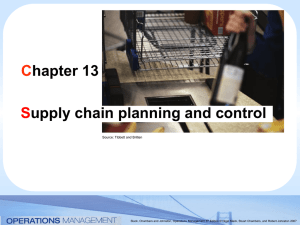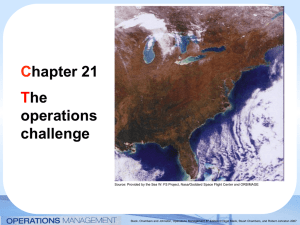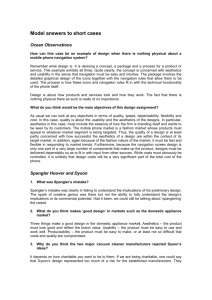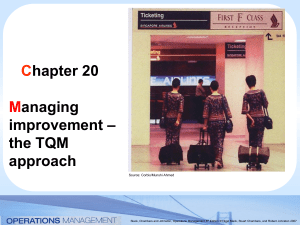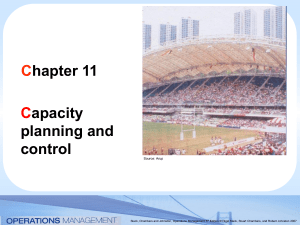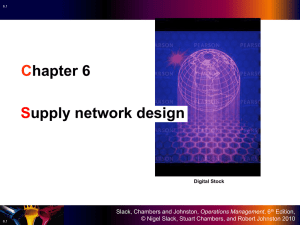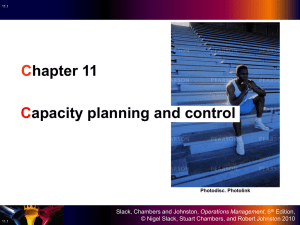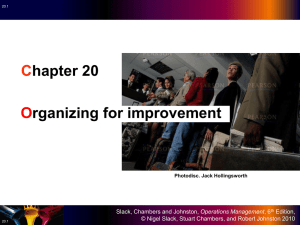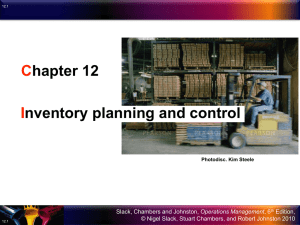Chapter 17 Powerpoint slides
advertisement
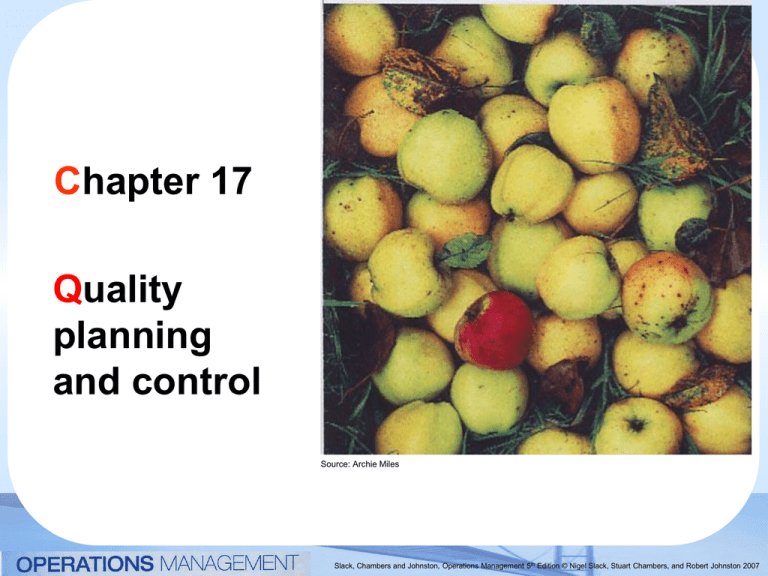
Chapter 17 Quality planning and control Source: Archie Miles Slack, Chambers and Johnston, Operations Management 5th Edition © Nigel Slack, Stuart Chambers, and Robert Johnston 2007 The various definitions of quality The transcendent approach views quality as synonymous with innate excellence. The manufacturing-based approach assumes quality is all about making or providing error-free products or services. The user-based approach assumes quality is all about providing products or services that are fit for their purpose. The product-based approach views quality as a precise and measurable set of characteristics. The value-based approach defines quality in terms of ‘value’. Slack, Chambers and Johnston, Operations Management 5th Edition © Nigel Slack, Stuart Chambers, and Robert Johnston 2007 Benefits from a quality focus Better Products Quality Focus Fewer Defects Slack, Chambers and Johnston, Operations Management 5th Edition © Nigel Slack, Stuart Chambers, and Robert Johnston 2007 Quality characteristics of goods and services Functionality – how well the product or service does the job for which it was intended Appearance – the aesthetic appeal, look, feel, sound and smell of the product or service Reliability – the consistency of performance of the product or service over time Durability – the total useful life of the product or service Recovery – the ease with which problems with the product or service can be rectified or resolved Contact – the nature of the person-to-person contacts that take place Slack, Chambers and Johnston, Operations Management 5th Edition © Nigel Slack, Stuart Chambers, and Robert Johnston 2007 Quality Quality fitness for purpose Quality of design degree to which design achieves purpose Reliability ability to continue working at accepted quality level Quality of conformance faithfulness with which the operation agrees with design Variables things you can measure Attributes things you can assess and accept or reject Slack, Chambers and Johnston, Operations Management 5th Edition © Nigel Slack, Stuart Chambers, and Robert Johnston 2007 The Economics of Quality Total Cost of Quality Control costs Failure costs Internal Prevention Appraisal Failure External Failure Slack, Chambers and Johnston, Operations Management 5th Edition © Nigel Slack, Stuart Chambers, and Robert Johnston 2007 Defining the costs of Quality Prevention : Costs associated with design and planning of a Quality programme Appraisal : Costs involved in the direct appraisal of quality both in plant and in field Internal Failure : Occurrence of defective product in plant External Failure : Failure of product or service in field Slack, Chambers and Johnston, Operations Management 5th Edition © Nigel Slack, Stuart Chambers, and Robert Johnston 2007 Dimensions of Service Quality Five principal dimensions that customers use to judge service quality. These dimensions are listed in order of declining relative importance to customers. Reliability Responsiveness Dependability Promptness of service Accuracy Service failure Reliability Slack, Chambers and Johnston, Operations Management 5th Edition © Nigel Slack, Stuart Chambers, and Robert Johnston 2007 Assurance Knowledge and Courtesy Competence Politeness and respect Effective communication Server attitude Slack, Chambers and Johnston, Operations Management 5th Edition © Nigel Slack, Stuart Chambers, and Robert Johnston 2007 Empathy Caring Individualised attention Approachability Sense of security Understanding Customer's needs. Tangibles Physical facilities Slack, Chambers and Johnston, Operations Management 5th Edition © Nigel Slack, Stuart Chambers, and Robert Johnston 2007 Quality Dimensions Word of Mouth Dimensions of Service Quality Reliability Responsiveness Assurance Empathy Tangibles Personal Needs Expected Service Past Experience Perceived Service Quality ES < PS Quality Surprise Perceived service ES = PS Satisfactory ES > PS Unacceptable Quality Slack, Chambers and Johnston, Operations Management 5th Edition © Nigel Slack, Stuart Chambers, and Robert Johnston 2007 Perceived quality is governed by the gap between customers’ expectations and their perceptions of the product or service Gap Gap Customers’ expectations for the Customers’ product or perceptions service of the product or service Customers’ Customers’ expectations perceptions of the for the product or product or service service Expectations > perceptions Expectations = perceptions Perceived quality is poor “Unacceptable Quality” Perceived quality is acceptable Customers’ expectations for the product or service Customers’ perceptions of the product or service Expectations < perceptions Perceived quality is good “Quality Surprise” Slack, Chambers and Johnston, Operations Management 5th Edition © Nigel Slack, Stuart Chambers, and Robert Johnston 2007 A ‘gap’ model of quality Previous experience Word-of-mouth communications The customer’s domain Customer’s expectations concerning a product or service Image of product or service Gap ? Customer’s perceptions concerning the product or service Gap 4 Customer’s own specification of quality Gap 1 Management’s concept of the product or service The actual product or service Organization’s specification of quality Gap 3 Gap 2 The operation’s domain Slack, Chambers and Johnston, Operations Management 5th Edition © Nigel Slack, Stuart Chambers, and Robert Johnston 2007 The perception–expectation gap Action required to ensure high perceived quality Main organizational responsibility Gap 1 Ensure consistency between internal quality specification and the expectations of customers Marketing, operations, product/service development Gap 2 Ensure internal specification meets its intended concept of design Marketing, operations, product/service development Gap 3 Ensure actual product or service conforms to internally specified quality level Operations Gap 4 Ensure that promises made to customers concerning the product or service can really be delivered Marketing Slack, Chambers and Johnston, Operations Management 5th Edition © Nigel Slack, Stuart Chambers, and Robert Johnston 2007 High quality puts costs down and revenue up Quality Qualityup up Rework Reworkand and scrap costs scrap costs down down Image Imageup up Service Service costs costsdown down Inventory Inventory down down Inspection Inspectionand and test costs test costs down down Sales Sales volume volumeup up Price Price competition competition down down Processing Processing time timedown down Complaint Complaintand and warranty costs warranty costs down down Scale Scale economies economiesup up Capital Capitalcosts costs down down Productivity Productivity up up Operation Operationcosts costs down down Revenue Revenue up up Profits Profitsup up Slack, Chambers and Johnston, Operations Management 5th Edition © Nigel Slack, Stuart Chambers, and Robert Johnston 2007
